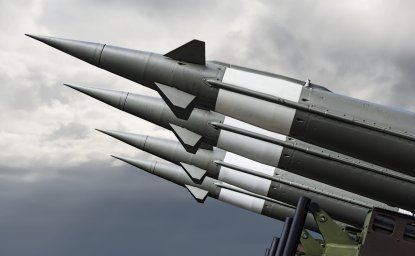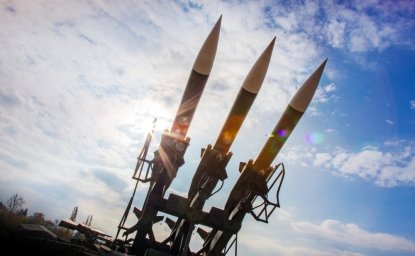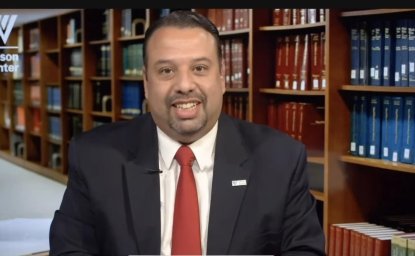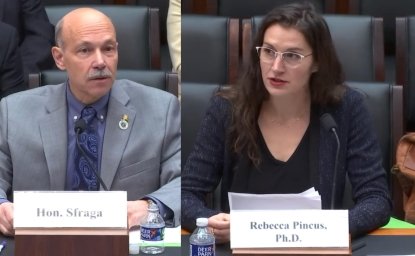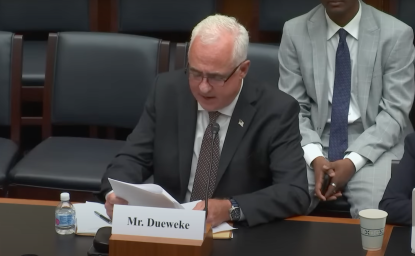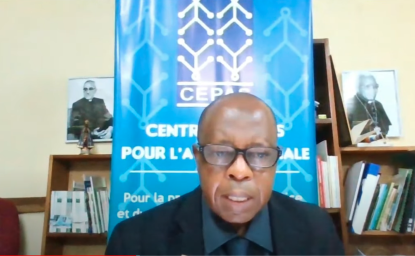The Way Forward on North Korea: Dealing with the Regime’s Growing Nuclear Threat
Submitted by Dr. Sue Mi Terry
Chairman Bera, Ranking Member Chabot, and distinguished members of the committee: I am honored to testify before you today to discuss the current impasse with North Korea and to discuss a way forward. These are my views alone, and do not necessarily represent the views of the Wilson Center or of the U.S. government.
North Korea’s nuclear program is, to borrow a term from USAID Administrator Samantha Power, a “problem from hell.” It is a problem that seems to be without an obvious solution—and the problem keeps getting worse. Since coming into a power a decade ago, North Korean leader Kim Jong Un has gone further than his father and grandfather in building up his weapons of mass destruction. Kim has conducted four out of six nuclear tests and over 130 missile tests, including three intercontinental ballistic missile (ICBM) tests in 2017 and one more recently on March 24th. The pace of the North’s military expansion has not slowed by the three widely publicized summits between Kim and President Trump in 2018 and 2019. In the past year, the North has tested a new submarine-launched ballistic missile, a train-mounted ballistic missile, a new surface-to-air defense missile system, a long-range strategic cruise missile, hypersonic missiles, and an ICBM, breaking its self-imposed testing moratorium. In the first three months of 2022 alone, the North launched 15 missiles. All these weapons are part of a regime effort to perfect its own missile and deterrent capabilities, to diversify its missile arsenal and to defeat American missile defenses. Kim is now even threatening to use his nuclear weapons preemptively—not just for deterrence.
Today, North Korea has amassed up to 60 nuclear warheads, and it is producing enough fissile material to make half dozen new bombs annually.[1] A 2021 Rand Corporation report projected that North Korea could have around 200 nuclear weapons and hundreds of ballistic missiles stockpiled by 2027.[2] The available evidence suggests that it can miniaturize these warheads to fit atop a missile.[3] Kim Jong Un is now likely moving to the next phase: placing multiple warheads on a single ICBM. This MIRV capacity will be designed to stymie limited U.S. missile defenses and enhance North Korea’s ability to strike the U.S. mainland with nuclear missiles—making North Korea one of just three countries in the world, along with Russia and China, to possess this dangerous capability.
Given this situation, my testimony today will begin with an overview of the current diplomatic and military state of play and will conclude my recommendations for U.S. policy toward North Korea.
What Kim Wants
North Korea’s overarching strategic goals remain breaking out of its diplomatic isolation, gaining international acceptance as a nuclear stakeholder, and strengthening its position on the peninsula, while eroding the U.S. alliance with South Korea. Pakistan is the North’s model in this regard: After its first nuclear test in 1998, Islamabad faced U.S. and U.N. sanctions, but they were soon eased, and after 9/11 the U.S.-Pakistan relationship transformed, and Pakistan was showered with aid.
In the short term, this means the North is committed to modernizing its nuclear and missile arsenal and is not interested in returning to talks with Washington or Seoul. The Biden administration has made it clear that the United States is willing to talk to the North Koreans without any preconditions, but Pyongyang has shown little interest in further dialogue with Washington since the failure of the three Trump-Kim summits. The North is likely to eventually return to talks, but only after the regime feels it has increased its long-term bargaining leverage. For the foreseeable future, the North Korean provocations are likely to continue, while prospects for diplomacy and negotiations between Washington and Pyongyang will remain low.
While the North is facing many internal challenges brought about by locking down its borders to prevent Covid-19 (it is facing the worst economic downturn since the famine years in the mid-1990s), the geopolitical environment is propitious for additional North Korean missile tests or even a nuclear test. In addition to seeing the value of the tests to meet its modernization goals, Kim likely believes testing has additional benefit of increasing his leverage when he eventually returns to dialogue.
With Russia at odds with the West over its invasion of Ukraine and Chinese President Xi Jinping preoccupied with the economic and political fallout of Russia’s war, Kim likely bets that neither Moscow nor Beijing is likely to agree to additional sanctions on North Korea at the UN Security Council. In fact, both Russia and China, which have been pushing for a relaxation of sanctions in recent years, couldn’t even condemn the latest ICBM launch, and they vetoed a Security Council resolution seeking additional sanctions on North Korea. This is practically an invitation for North Korea to carry out fresh provocations.
The Russian invasion of Ukraine will only likely redouble Kim Jong Un’s determination to expand his nuclear arsenal. Ukraine gave up its nuclear arsenal in 1994 and is now being invaded by Russia. Kim no doubt figures that if Ukraine were still a nuclear power, Russia would not have dared to attack. For Kim, Ukraine’s experience thus only reinforces the lessons that his fellow dictators in Iraq and Libya learned the hard way: countries that give up their WMD programs become vulnerable, and their leaders face serious risks of being overthrown and killed. Therefore, from Kim’s perspective, nuclear capability provides the North a fairly low-cost insurance policy to prevent South Korea and the US from again invading North Korea (as they did in 1950 after North Korean launched a war of aggression against the South). Kim will continue to view the North’s nuclear weapons as a military asset, an insurance policy, and a source of power and prestige for the regime.
North Korea’s nuclear arsenal and doctrine
Since North Korea crossed the twin thresholds of developing thermonuclear weapon and a flight-tested ICBM in 2017, North Korea has focused on expanding and modernizing its arsenal by developing a range of new capabilities, with a focus on prompt strike, improved survivability, and defeating missile defenses.
In the past year, North Korea has tested a new submarine-launched ballistic missile (SLBM), a train-mounted ballistic missile, a new surface-to-air defense missile system, a new, long-range strategic (nuclear-capable) cruise missile, multiple hypersonic missiles, and most recently, an ICBM in March and a short-range nuclear-capable missile in April, and another SLBM in May. The North is working on transitioning its nuclear force development to a new phase, one that is focused on refining the higher-end capabilities, including ICBMs, to become more precise and capable, allowing, for example, delivery of multiple independently targetable reentry vehicles, or MIRVs. Recent satellite imagery also shows continued construction work at the Punggye-ri nuclear test site, and the State Department has confirmed that the US government assesses the site could be ready for another nuclear test this month.
The North is also developing tactical nuclear weapons intended for use against targets on or near the peninsula. At the January 2021 Eighth Party Congress of the Workers’ Party of Korea (WPK), Kim Jong Un presented a list of advanced capabilities to expand. But notably, in reviewing the accomplishments of the past five-year period, Kim stated that the North had already accumulated nuclear technology to such a high degree as to “miniaturize, lighten, and standardize nuclear weapons and to make them tactical ones and complete the development of a super-large hydrogen bombs.”[4] He boasted that the North had developed “ultra-modern tactical nuclear weapons including new-type tactical rocket and intermediate-range cruise missiles whose conventional warheads are the most powerful in the world,” among other accomplishments, and vowed to continue to make nuclear weapons smaller and lighter for more tactical uses. On April 16th, the North tested a new short-range nuclear-capable missile, which the regime described as a new type of “tactical guided weapon” to strengthen its “tactical nuclear operation.”[5] A key risk is that tactical nuclear weapons are designed for use against the South, aimed ultimately at decoupling the US—ROK alliance. Kim likely calculates that even if he uses tactical nuclear weapon preemptively, while holding long-range ICBM force in reserve and threatening retaliation against the US mainland, it will not necessarily lead to escalation. Kim may calculate that North Korea can now deter nuclear retaliation in kind by Washington.[6]
A risk of preemptive use has increased as the regime has recently made repeated ominous warnings that the regime envisions wider roles for the North’s nuclear arsenal beyond deterrence and self-defense. Speaking at a military parade on April 25th, Kim warned that the North will use its nuclear weapons not just to prevent war but even preemptively for “secondary purpose” if his country’s interests are threatened.[7] This statement comes after Kim’s sister, Kim Yo Jong, had already made similar threats about potential preemptive use earlier in the month, threatening that the South could face “extermination.”
The Path Forward: A Multi-Prong Strategy
Given this worrisome situation, how should the U.S. move forward in the coming months and years?
With the North poised to conduct possible nuclear weapons test any day, some Korea analysts are calling for Washington to be more innovative and bolder in its North Korea policy, including extending an olive branch to Pyongyang. This would require preemptive sanctions relief, probably the only acceptable incentive for the Kim regime, but would likely result in North Korea pocketing the concessions and continuing its WMD programs anyway.
It is tempting to reach for creative solutions—to imagine that years of gridlock and frustration with the North can be broken through some offer from the West. But the difficult and uncomfortable reality is that no US president over five administrations has found any way to “solve” the North Korean problem. There are no “out of the box” solutions available; they have all been tried aside from launching a preemptive war against North Korea—which would be exceedingly foolish and dangerous.
Given that the US will not be able to turn back the clock on North Korea’s nuclear program and no amount of aid or economic incentives will change the North’s calculation, the only realistic path forward is (1) in the short to mid-term, manage and reduce the North Korean threat by increasing U.S. and our allies’ deterrence, defense, and containment posture and( 2) pursue a long-term strategy of helping the North Korean people through information penetration campaign.
Denuclearization as a goal must still be pursued, at least rhetorically. Many Korea watchers point out that the North is a de facto nuclear state like Pakistan, and it is unrealistic for Washington to keep insisting on a goal that it is unlikely to ever achieve. While there is validity to this argument, Washington cannot give up on the goal of achieving denuclearization, at least rhetorically. Even though, in reality, North Korea is a nuclear weapons power, accepting North Korea as a de facto nuclear state like Pakistan will bring about significant risks for the US and the region. There is a real possibility of regional proliferation—US allies, including South Korea and Japan, could lose confidence in the US nuclear umbrella and feel compelled to field their own nuclear weapons, setting off a destabilizing nuclear arms race across the region. There is also the risk of global proliferation. If Kim Jong Un believes that his nuclear and missile programs provide some degree of protection for his behavior, his cash-strapped regime could be even tempted to sell nuclear weapons, materials, or expertise to other states and nonstate actors. Moreover, while North Korea is unlikely to launch a missile or nuclear attack against the US knowing it would suffer devastating retaliation, once accepted as a nuclear weapons power, an emboldened North Korea with growing capabilities could increase its provocations, including cyber-attacks. In the past, Pyongyang assisted Syria in building a nuclear reactor and sold missiles to countries like Iran and Syria. Finally, once the North is allowed to “get away” with its nuclear status, it sends the wrong message to other rogue actors who are seeking to pursue nuclear capabilities too.
Expand and implement sanctions. Sanctions are one tool that we need to expand while recognizing that returning to the maximum-pressure policy of 2017 will remain difficult as long as China and Russia do not prioritize sanctions enforcement. The sanctions the George W. Bush administration imposed in 2005 on Macau’s Banco Delta Asia, where North Korea kept some of its cash, were one of the few steps Washington has taken that genuinely got Pyongyang’s attention. Yet only two years later, the US agreed to release $25 million in frozen funds to spur six-party talks. North Korea also noticed when Trump doubled down on sanctions and authorized the US Treasury Department to block from the US financial system any foreign business or individual that facilitates trade with Pyongyang. By late 2017, about 90 percent of North Korean exports were illegal under international law. On top of far-reaching US sanctions, nine major Security Council resolutions had banned the country’s most lucrative exports—coal, iron ore, seafood, and textiles, among others—which had been netting the regime $3 billion a year. But since Trump’s shift to summitry and diplomacy, China and Russia have shifted away from implementing sanctions. Beijing and Moscow have most recently vetoed a UNSC resolution calling for additional sanctions in the aftermath of the recent ICBM test.
The best option for the Biden administration now is to further target the North’s illicit revenue streams and foreign bank accounts. It should consider expanding secondary sanctions on financial institutions that aid the Kim regime, including those in China. Bipartisan majorities in Congress, working closely with both the Obama and Trump administrations, overwhelmingly passed mandatory North Korea sanctions in 2016, 2017, and 2019.[8] These laws give the Biden administration a clear mandate and powerful tools to crack down further on North Korea’s financial networks. Under the 2019 Otto Warmbier Act, the Biden administration has the power to sanction financial institutions that are helping the North to evade UN sanctions. The United States needs to send a simple, direct message to foreign financial firms, particularly Chinese firms: You can do business with North Korea, or you can do business with the United States, but you can’t do business with both. The model should be the tough sanctions that the United States imposed on Iran before reaching a deal on Tehran’s nuclear activities in 2015. Sanctions should be eased only if North Korea takes verifiable and irreversible steps toward denuclearization.
Strengthen regional deterrence and defense capabilities, military readiness & counterproliferation measures. This includes enhancing theater missile defense systems around the Korean Peninsula, Japan and at sea; introducing more advanced air and naval assets into the region; developing and deploying more sophisticated US and South Korean strike capabilities and rotational presence of US Navy ships at Korean naval bases; reinforcing Washington’s extended deterrence against North Korea; and again staging regular robust military US-Korea joint exercises (they were scaled back since Trump summits with Kim). The US and South Korea should then examine options for South Korean military units to participate in more military exercises across the Indo-Pacific region, including with Australia, India, the Philippines, and the members of the Association of Southeast Asian Nations (ASEAN). Washington and Seoul should also consider whether additional US Terminal High Altitude Area Defense (THAAD) missile defense batteries should be deployed as a response to the North’s expanded nuclear and missile arsenal, despite China’s opposition. Finally, the US will need to build a coalition of nations to not only enforce sanctions but to prevent onward proliferation on the ground, at sea, and in the air—in particular, when the covid pandemic is over and North Korea once again resumes legal and illicit trade. This would require more robust counterproliferation measures, including interdicting, boarding, and inspecting all North Korean ships and/or aircraft suspected of sanctions violations or arms sales.
Bolster U.S.-Korea-Japan trilateral cooperation. Working with the incoming Yoon administration, the Biden administration now has an opportunity to encourage Seoul and Tokyo to take steps to reconciliation and bolster trilateral cooperation to improve deterrence of North Korea. The first step towards improving trilateral cooperation is to encourage intelligence sharing between Washington, Seoul, and Tokyo. In this respect, the near collapse of General Security of Military Information Agreement (GSOMIA) in late 2019 is highly concerning for the US; GSOMIA allows the two countries to share intelligence directly, a more streamlined process than going through the United States. This would reduce the chances of miscommunication in the event of a crisis when timeliness and efficient communication is crucial. The second step is to encourage Seoul and Tokyo to start regular trilateral exercises with the US for air defense and ballistic missile defense (BMD) and to launch combined exercises that demonstrate integration of their collective capabilities. South Korea and Japan are already working with the United States to build missile defense systems that are increasingly interoperable with US defenses. But to ensure coordinated response and mitigate against the North Korean threat, South Korea and Japan needs to improve their interoperability in all dimensions—human, procedural, and technical. To successfully deter and defend against the North Korean missile threat, we need to detect launches as soon as possible, track them, and intercept them as early in flight as feasible. This requires interoperability among various missile defense capabilities to include command and control networks, sensors, and Integrated Air and Missile Defense systems. In missile defense, the whole is greater than the sum of the parts. In sum, whenever possible, the US should encourage closer military ties between these two critical alliances to ensure and upgrade our deterrent against the North.
Leave the door open to diplomacy. While the West should remain resolute in the face of North Korean provocations and its WMD buildup, Seoul and Washington should not be afraid to talk with Pyongyang. If the North does decide to return to negotiations, the US should test the waters to see if it would be possible to conclude an initial deal that would freeze North Korean WMD program in a verifiable manner in return for partial sanctions relief from the United States. But it would need to be more equitable than North Korea’s demand at the Hanoi summit for most of the sanctions being lifted in return for only a partial nuclear shutdown. The deal would need to, at a minimum, get the North to freeze both the plutonium and uranium operations in and around Yongbyon nuclear complex, stop testing missiles and nuclear weapons, and stop its fissile material production. While is still unlikely that the North would agree this sort of the deal with the same kind of intrusive inspections that Iran allowed, it is still less unrealistic than to imagine that a grand bargain can be struck that would result in North Korea’s complete denuclearization. If nothing else, a willingness to engage in such limited negotiations will enable Washington to win the “battle of the narrative” by showing the world that it is genuinely interested in peace and that the primary obstacles to an agreement lie in Pyongyang. Finally, in humanitarian aid, there may be an opportunity to engage with the North. North Korea is one of only the two countries in the world that has not vaccinated any of its population; if it can be managed, a vaccination initiative that the North accepts could at a minimum create better atmospherics while being the right thing to do from a humanitarian perspective.
Maintain a long-term strategy of helping the North Korean people: focus on human rights and information penetration. While taking steps to cut off the resources that fund the North Korean WMD program, the US and its allies should continue to make concerted public diplomacy efforts intended to inform and influence the North Korean public. As part of this effort, the US and its allies will need to prioritize human rights abuses in North Korea and information penetration campaign. The US and South Korea could do more at the UN and other international forums to highlight North Korean human rights violations. To date, promoting human rights in North Korea has taken a backseat in US policy behind denuclearization. But applying pressure for human rights improvements also provides a means of applying pressure to change North Korea beyond what economic sanctions can apply. When West Germany established a Central Registry of State Judicial Administrations and systematically documented cases of human rights abuses in East Germany, this increased the pressure on the Communist regime. It is important to realize that North Korea’s nuclear program and its systematic abuses of human rights against its own people are inseparable. North Korea certainly would not be anywhere near the current level of nuclear capability if it did not chronically deprive its population of resources and engage in other systematic abuses of human rights. Putting pressure on North Korea to improve the human rights situation can, thus, reduce the resources available to the regime for its military buildup.
The US and its allies will need to also take more proactive steps to break North Korea’s information blockade—to help the North Korean people learn more about the true state of the world and to become less dependent on regime propaganda. Despite regime’s extreme efforts to block foreign content, both ordinary and elite North Koreans are risking their lives to learn more about the outside world. Due to this demand for foreign and unauthorized content, outside information and media have been trickling into the North and have been sparking irreversible social changes throughout the country. While there have been several US and South Korean government-funded programs that target North Koreans, most information dissemination efforts have been led by under-resourced small NGOs based in the US and South Korea. A greater coordinated and concerted US policy that aims to provide diverse and truthful content to North Koreans could help bring about incremental changes, one that, over the long run, convince people to prefer and demand a different and freer country for themselves. Part of this effort could involve bringing in more digital media and cell phones into North Korea and making Internet service more widely available, perhaps from space-based platforms.[9]
Conclusion: The Cold War Model
In the ten years since Kim Jong Un came into power, the North has not liberalized as many expected. Instead, it has maintained its police state while making worrisome progress in advancing its nuclear and missile capability. The United States has no good option beyond containment and deterrence. The model is the Cold War when the US patiently pursued the containment and deterrence of the Soviet threat until, after more than half a century, the Soviet Union peacefully imploded. Ultimately the only way to remove the North Korean threat is for there to be a change of policy in North Korea with a change in leadership that is more responsive to the needs of its people and thus is willing to curtail or abandon its nuclear ambitions. But this would have to be peaceful, internally driven change—it is not something that the US or South Korea can force from the outside. The best the West can hope for is to limit the North Korean threat while incrementally creating the conditions to compel North Korea—whether in one year or one hundred years—to pursue a different policy in the long term.
[1] “Nuclear Weapons: Who Has What at a Glance,” Arms Control Association, January 2022. https://www.armscontrol.org/factsheets/Nuclearweaponswhohaswhat
[2] Bruce W. Bennett, Kang Choi, Myong-hyun Go, Bruce. E. Bechtol, Jr., Jiyoung Park, Bruce Klingner, Du-Hyeong Cha, “Countering the Risks of North Korean Nuclear Weapons,” Rand Corporation, April 2021. https://www.rand.org/pubs/perspectives/PEA1015-1.html
[3] Joby Warrick, Ellen Nakashima, and Anna Fifield, “North Korea now making missile-ready nuclear weapons, U.S. analysts say,” The Washington Post, August 8. 2017. https://www.washingtonpost.com/world/national-security/north-korea-now-making-missile-ready-nuclear-weapons-us-analysts-say/2017/08/08/e14b882a-7b6b-11e7-9d08-b79f191668ed_story.html?utm_term=.4999c4ebbf7a
[4] Kim Jong Un, “On Report Made by Supreme Leader Kim Jong Un at Eight Party Congress of WPK,” Korea Central News Agency, January 25, 2021. Summarized and published by the National Committee on North Korea (NCNK), https://www.ncnk.org/resources/publications/kju_8th_party_congress_speech_summary.pdf/file_view
[5] “Respected Comrade Kim Jong Un Observes Test-fire of New-type Tactical Guided Weapon,” KCNA, April 17, 2022. http://kcna.kp/en/article/q/ef857f3a6a119b3cd07e76774404678c.kcmsf
[6] For a full analysis of such an argument, see Ankit Panda, “A Call to Arms: Kim Jong Un and the Tactical Bomb,” The Washington Quarterly, 44:3 September 22, 2021.
[7] Chaewon Chung and Ethan Jewell, “Kim Jong Un: Nuclear forces are for more than just preventing war,” NK News, May 6, 2022. https://www.nknews.org/2022/04/kim-jong-un-nuclear-forces-are-for-more-than-just-preventing-war/?t=1659644329648
[8] See Congress.gov., H.R.757m “North Korea Sanctions and Policy Enhancement Act of 2016,” H.R. 3364, “Countering America’s Adversaries Through Sanctions Act.”
[9] For a detailed, solutions-oriented policy recommendations to inform, influence and empower North Koreans, see Jieun Baek edited, “A Policy of Public Diplomacy with North Korea: A Principled and Pragmatic Approach to Promote Human Rights and Pursue Denuclearization,” Harvard Kennedy School Belfer Center for Science and International Affairs, August 2021, https://www.belfercenter.org/sites/default/files/2021-08/KoreaWG-2021.pdf.







